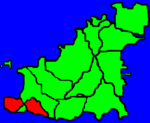|
Parish of Torteval
The parish is split into two parts by the parish of St Pierre du Bois. Torteval is Guernsey’s smallest parish with a population of less than a thousand. Torteval means ‘twisting valley’ in Guernesiais. In the centre of the parish is Torteval parish church. It was built on the site of the Church of St Philippe that had fallen into disrepair in the 18th century. It has an unusual round tower and the tallest spire in the island which was intended to be used by ships as a marker. It also has one of the oldest bells in the Channel Islands. Sir John Doyle laid the foundation stone in 1816. The Rocquaine regatta is a unique local event that takes place around Rocquaine Bay every August. Rocquaine has the highest section of sea wall in Guernsey reaching a height of 40ft. The sheltered cove of nearby Portelet is a child’s paradise in summer. The harbours of Rocquaine and Portelet are used both professional and hobby fishermen for their small fishing craft. Portelet, as its name implies, is a little port once historically used by parishioners and their carts to collect vraic and the home port of the keepers of the lighthouse. The Hanois lighthouse can be seen standing on the rocks about a mile off Pleinmont point. It was completed in 1862 after many ships were wrecked on Guernsey’s dangerous south-west coast. One disaster was in 1807, when the Boreas, small naval frigate, was lost with half her complement of 154 men. Between 1835 and 1862, no fewer than 97 ships were lost or stranded. After the lighthouse came into use until 1975, there were only 14 wrecks. The lighthouse was one of the last in the British Isles to have an automatic light which meant that there didn’t have to be a lighthouse keeper on site. Two 3-man crews used to have to each work 28 day shift on the lighthouse. Creux Mahie – the cave is believed to be the biggest in the Channel Islands and is non-tidal. It is 57 metres long, 18.5 metres wide with a height range from 6 to 18 metres. It is the subject of much folklore and was used by smugglers up to the 19th century. La Table des Pions is an ancient circular trench cut into the turf. Also known as the fairy ring, it has a centre part raised as a table and it is believed to have been a meeting place for these mythical creatures, hence the name. Post-war hermit Steve Picquet made his home in one of the German bunkers at Pleinmont. He shared it with his dog and 30 goats. He passed away on 21st August 1963 aged 74. Mr Picquet’s self-imposed solitary lifestyle made him something of a celebrity. He appeared on the Alan Whicker television program and three pages of G.B. Edward’s Book of Ebenezer Le Page are dedicated to him. He named his bunker home ‘Onmeown’. In the Parish is Guernsey’s only example of a colombier, also known as seigniorial dovecote. It stands in a field behind a very attractive farmhouse, also called Le Colombier, to the north-east of Torteval Church. It dates back to at least 1330. The circular tower has the inside of the walls lined with pigeon holes in which birds nested. The pigeons were an important source of meat during the winter. Torteval’s first scarecrow weekend was held in 2004 and is now an annual event with over 60 imaginative and colourful scarecrow creations. Features of Toterval include: |



